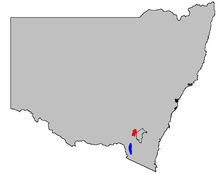Pseudophryne pengilleyi
| Corroboree frog | |
|---|---|
 |
|
| Southern corroboree frog (Pseudophryne corroboree) | |
| Scientific classification | |
| Kingdom: | Animalia |
| Phylum: | Chordata |
| Class: | Amphibia |
| Order: | Anura |
| Family: | Myobatrachidae |
| Genus: | Pseudophryne |
| Binomial name | |
|
Pseudophryne corroboree J. A. Moore, 1953 |
|
 |
|
| Distribution of P. corroboree in blue, P. pengilleyi in red, in New South Wales | |
|
Pseudophryne pengilleyi Wells and Wellington, 1985 |
|
The corroboree frogs are two species of small, poisonous ground dwelling frogs, native to Southern Tablelands of Australia. The two species are the southern corroboree frog (Pseudophryne corroboree) and the northern corroboree frog (Pseudophryne pengilleyi). They are unique among frogs in that they produce their own poison rather than obtain it from their food source as is the case in every other poisonous frog species.
Corroboree frogs have different patterns. The corroboree frog is found only in 400 km² patches in the sub-alpine regions of southern New South Wales and Victoria, Australia.
The northern form deviates slightly in having narrow yellow to greenish stripes and is slightly smaller.
Sexual maturity of P. corroboree is reached at four years of age, with one year as an embryo/tadpole and two years as a juvenile/subadult. Adults primarily have only one breeding season. Breeding occurs around December terrestrially near shallow pools, fens, seepages, wet grassland or wet heaths, where the males build chamber nests within the grasses and moss. Males compete for females via song. Each male will attract up to ten females to his burrow sequentially and may dig a new burrow if his first is filled with eggs. The female lays up to 38 eggs and the male grasps her and deposits sperm directly onto the eggs. Tadpoles develop but remain within the protective egg coat until hatching occurs when high ground-water levels after rain cause the nest to become flooded at 4 to 6 months. Tadpole development takes six to eight months. Metamorphosis occurs between December and February (Osborne and Norman 1991). P. pengilleyi prefers to breed in sphagnum bogs and wet heath in sub-alpine areas and dense patches of herbs in openings or seepages amongst fallen tussocks at lower elevation (bog pools at high altitudes above 1300 m and in shallow seepage pools in gullies at lower altitudes of 1000–1400 m). Other reproductive details are as for P. corroboree. Both species are restricted to mountain and sub-alpine woodlands, heathlands and grasslands.
Non-breeding habitat for both species occurs in forest, woodland and heath adjacent to breeding sites.
The typical diet of a mature corroboree frog includes; beetles, mites, ants and insect larvae. However, as tadpoles they also tend to eat algae and other small pieces of organic material found in their pools.
...
Wikipedia

